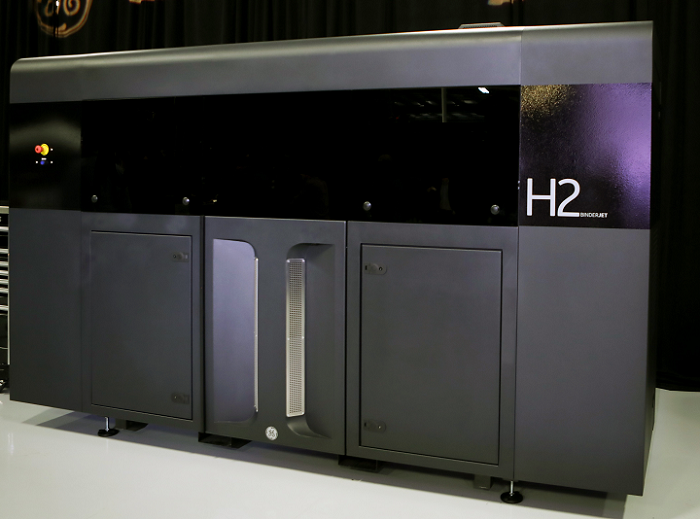
A 3D printing process developed at Oak Ridge National Laboratory repairs and strengthens a Cummins engine without the need to recast parts, which saves on costs and energy. [Image: Brittany Cramer, ORNL]
To this end, the company is expanding its additive manufacturing portfolio with an investment in metal 3D printing -using binder jet technology by its strategic partner GE Additive, to be exact. Shaun Wootton, GE Additive’s PR and Media Relations Leader, told us that Cummins is “one of the first customers to invest in our binder jet technology.”
 Binder jetting involves moving a print head across a bed of powder, while at the same time selectively depositing a liquid agent in the desired shape into the powder. This binds the two areas together so that a solid part forms a layer at a time. This method of 3D printing can print parts 60 to 100 times faster than processes that are laser-based, depending on how complex the final product is. This strategic investment – part of Cummins’ implementation of Industry 4.0 – is the next logical step to make in revolutionizing its manufacturing processes.
Binder jetting involves moving a print head across a bed of powder, while at the same time selectively depositing a liquid agent in the desired shape into the powder. This binds the two areas together so that a solid part forms a layer at a time. This method of 3D printing can print parts 60 to 100 times faster than processes that are laser-based, depending on how complex the final product is. This strategic investment – part of Cummins’ implementation of Industry 4.0 – is the next logical step to make in revolutionizing its manufacturing processes.
“By investing in 3D metal additive technologies from GE Additive, we are investing in Cummins and our customers. This technology has the potential to provide our customers with a quicker, lower-cost production method that ultimately uses less energy, which means we can better serve our customers and reduce our environmental impact,” said Tim Millwood, Vice President of Global Manufacturing at Cummins Inc.
Cummins already has two Concept Laser M2 DMLM systems, one of which is located at its Technical Center; the other is installed, along with two other metal 3D printers, at its Research and Development Center in Mexico. In fact, the first 3D printed metal part the company sold – a low-volume bracket – was fabricated on one of its M2 printers. By adding new binder jet 3D printers, which will be located at GE Additive’s Cincinnati, Ohio lab, Cummins will be able to reliably print complex parts of both medium and large sizes at a lower cost and higher throughput. This means the company will be able to focus its future strategy on high-volume production, though it’s currently 3D printing low-volume parts only as a way to study, as Cummins put it, “how best to use 3D technology in higher volume manufacturing.”
GE Additive has been working hard to rapidly scale its binder jet technology over the last few years. Its complete, industrialized factory solution should be commercially available in the early part of 2021.
“In early 2019, we launched the beta testing and partner program and deliberately sought out partners and key customers, like Cummins, who are committed to mass production. As Cummins celebrates its 100th year, it remains steadfast in its commitment to being at the cutting edge of innovation. Above all, we want to partner with companies whose businesses and customers will benefit tremendously from binder jet technologies,” said Jake Brunsberg, Binder Jet Product Line Leader.
Teams from Cummins will be co-located at GE Additive’s Cincinnati lab in order to work together on technology development. Later this year, the 3D printers will be relocated to one of the company’s own facilities. This investment will definitely help speed up its course toward scaled additive manufacturing production.
Discuss this story and other 3D printing topics at 3DPrintBoard.com or share your thoughts in the Facebook comments below.
Subscribe to Our Email Newsletter
Stay up-to-date on all the latest news from the 3D printing industry and receive information and offers from third party vendors.
Print Services
Upload your 3D Models and get them printed quickly and efficiently.
You May Also Like
U.S. Navy Lab Uses 3D Printing to Reduce Tooling Lead Time By Over 90%
The F-35 Lightning II Joint Program Office (JPO), responsible for life-cycle management of the key fifth-generation joint strike fighter (JSF) system used by the U.S., its allies, and its partners,...
Etsy Design Rule Change Reduces Selection of 3D Printed Goods
Online marketplace Etsy has implemented a rule change requiring all 3D printed goods on the site to be original designs. The update to the site’s Creativity Standards states, ¨Items produced using...
Honeywell Qualifies 6K Additive’s Nickel 718 for 3D Printed Aerospace & Defense Parts
6K Additive is renowned for manufacturing sustainable additive manufacturing (AM) powder, and offers a wide portfolio of premium metal and alloy powders that include titanium, copper, stainless steel, and nickel,...
MetalWorm Sells WAAM Systems to Research Institutes in Brazil and Malaysia
Turkish WAAM firm MetalWorm has sold a system in Malaysia and another in Brazil. This is an excellent example of a few emerging trends in additive. Firstly, WAAM was experimented...


































